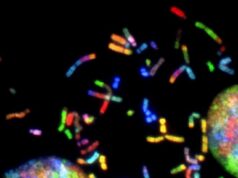Mice with the genetic defect that causes Fragile X syndrome (FXS) learn and remember normally, but show an inability to learn new information that contradicts what they initially learned, shows a new study by a team of neuroscientists. FXS is the most common genetic cause of intellectual disability and autism.
“These findings suggest that neural circuits in FXS may be fundamentally intact but improperly tuned, which results in inflexibility in gaining certain types of knowledge,” explains André Fenton, a professor in New York University’s Center for Neural Science and the senior author of the paper, which appears in the journal PLOS Biology. “We now have a better understanding of a cognitive deficit that is characteristic of FXS–excessive recollection of the information that was once accurate and an inability to process corrective material.”
The study, co-authored with Dino Dvorak, a post-doctoral fellow in NYU’s Center for Neural Science, focuses on the hippocampus. This part of the brain is crucial for memory, especially about space, which requires both encoding and remembering information.
However, because the same neurons are active in both encoding and remembering, it’s unknown what neural events control whether hippocampal neurons are encoding current experience into memory or recollecting information from memory. This dynamic is one of the keys to better understanding FXS, which impairs use of memory in multiple ways.
To explore this, first the scientists had to uncover an electrophysiological “signature of recollection” in hippocampus–a mapping that pinpointed whether these neurons are encoding current experience into memory or recollecting information from memory.
Find your dream job in the space industry. Check our Space Job Board »
This resulted in two primary findings.
Specifically, they found that encoding and recollection are the result of a neural “tug-of-war” between two distinctive types of rhythmic neural synaptic activity within the hippocampus. Notably, encoding occurs when fast rhythmic activity overwhelms slower rhythmic activity; by contrast, recollection occurs when the slower rhythm dominates the medium rhythm.
The second finding, which sheds new light on FXS, shows that FXS mice have an excessive amount of the slow rhythm.
FXS hippocampus neurons are normal, and, as a result, FXS mice can learn and remember in the ways other mice do. However, due to excessive dominance of the slow rhythm in FXS mice, these mice fail to learn new information that specifically contradicts what they initially learned–in other words, the neural tug-of-war is too often won by the slower rhythm, preventing normal adaptive flexibility of cognitive function.
“This cognitive behavioral inflexibility is characteristic of FXS and autism and now is explained by excessive recollection of the formerly correct but currently incorrect information that is stored in the hippocampus,” Fenton observes.
Provided by:
New York University
More information:
Dino Dvorak et al. Control of recollection by slow gamma dominating mid-frequency gamma in hippocampus CA1, PLOS Biology (2018). DOI: 10.1371/journal.pbio.2003354
Image:
SG dominates MG prior to successful place avoidance.
Credit: Dino Dvorak Basma Radwan Fraser T. Sparks Zoe Nicole Talbot André A. Fenton











